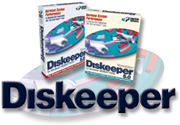When Microsoft was looking
for a defragging tool to include with Windows 2000, they
went calling on Executive Software. On every Win2K CD-ROM
you will find a manual defragmenter based on Executive
Software's technology. When I went looking for a
defragging tool, I looked no further than the full-blown
version of Diskeeper 5.

While Executive Software is
best known as an NT defragger, it has been in the
disk defragging business since before NT. They
produced a defragmenter for Digital's VAX VMS.
When Microsoft brought out NT, Executive Software
was the first to defrag NTFS disks. It was
probably inevitable that Symantec came along with
Norton Speed Disk for NT. Diskeeper kept its lead
with network scheduling and the ability to
defragment paging files and the Master File Table
(MFT). Besides Windows NT and Windows 2000,
Diskeeper now works on Windows 95 and 98.
I last looked at Diskeeper when it was in
the closing months of v3.0. It did a decent job of
defragmenting my disk. Version 4.0 added the ability to
defragment paging files. While this might have been a big
advance technically - NT locks paging files for exclusive
use - I didn't find this to be a major enhancement from a
user point of view, so I stayed with 3.0.
I did have one problem that v3.0 did not
solve: a fragmented Master File Table. The MFT is one of
the critical disk structures on an NTFS volume. Its
function is roughly analogous to the File Allocation
Table on a FAT partition, but it considerably more
complex. When a disk is formatted as NTFS, NT creates the
MFT and reserves some space for its expansion. If disk
space gets tight, NT can create files in the space
reserved for MTF expansion. This will result in a
fragmented MFT as it expands around files. A fragmented
MFT hurts performance. This is the biggest reason why you
should never let an NTFS volume get more than about 75%
full.
Another two factors that can cause MFT
fragmentation are converting partitions from FAT to NTFS
and resizing partitions with a utility like Partition
Magic. The first factor occurs with almost every NT
installation. During installation, even if you tell NT
that you want your primary partition to be formatted
NTFS, it actually creates a FAT partition. Later during
the installation the partition gets converted to NTFS.
I had an NTFS partition that had been
converted from FAT, resized a few times using Partition
Magic, and filled to about 90% more than once. As a
result, although my files had been defragmented quite
well, the MFT was badly fragmented. My MFT was 20MB in
size, with 83% in use. It had an astounding 565 fragments.
There are a total of three disk
structures that even v5 of Diskeeper is unable to
defragment while NT is running - paging files, the MFT,
and directories (directories can be moved on-line with
Windows 2000.) For all three, you must queue up jobs to
be run prior to NT loading completely. Defragging these
structures can take a long time and this is the one thing
that I find inconvenient about Diskeeper. Unless you can
afford to have your computer down for several hours, it
is best to only queue up a single task for a single
volume at a time, at least until you are familiar with
how long it takes to handle your disks. Fortunately,
these tasks are ones that should not have to be run too
frequently.
Defragging these disk structures is one
area where Norton Speed Disk has leap-frogged ahead of
Diskeeper. Speed Disk does have the ability to defrag
them while NT is running. Executive Software maintains
that it cannot be done safely and takes the safer course
of only doing it before NT loads fully. Although I have
always had a strong tendency to trust programs with the
Norton name on them, in this case I wonder. Microsoft has
stated that this is not a safe operation. For more
information on Microsoft's position, you can read an
article at:
http://www.gcn.com/vol19_no6/enterprise/1510-1.html
Diskeeper can be run in an interactive
mode any time you want. It can perform an analysis and
report the level of fragmentation among files,
directories, paging files, and the MFT. A colour-coded
map of your disk gives a good overview of how fragmented
things are. A single click on a button starts the
defragmentation process.
Computers should make life easier and
interactively defragmenting disks is only slightly more
exciting than watching paint dry. Fortunately, Diskeeper
has a "set it and forget it" mode. Through it
you can set a schedule for automatically defragging all
your volumes in the background. You don't have to stop
using your computer while it operates and you can set the
priority the program runs at. By default, it runs at the
lowest priority, which means it will not take CPU cycles
away from your running programs. Once you configure the
"set it and forget it" mode, you should never
have to be concerned about file fragmentation again. The
server version of Diskeeper has the ability to set the
schedule on all Diskeeper machines on the network.
I tested Diskeeper 5 on Windows NT 4 with
NTFS partitions and Windows 2000 with FAT32 partitions.
It performed well on both platforms. I never felt it was
impacting the performance of other running applications.
The "set it and forget it" mode runs in the
middle of the night and keeps the disks in good shape. I
did not try to do precise measurements due to the
difficulty in doing controlled tests. Personally, I did
not notice a big difference in performance on either
machine, but there have been tests performed by
independent labs such as NSTL that have found some pretty
dramatic performance boosts from defragmenting. I do feel
more confident knowing my disks are defragmented.
Bottom Line:
Diskeeper 5 (Proprietary)
US $44.95
Executive Software
http://www.executive.com/execsoft.asp
Originally published: May, 2000